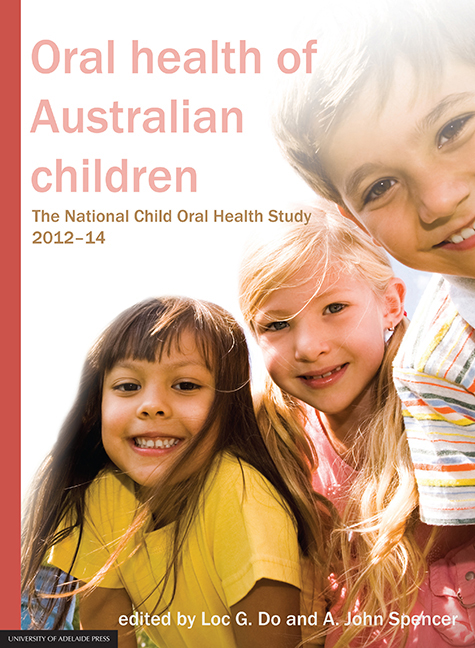Book contents
- Frontmatter
- List of Contributors
- Contents
- Preface
- Executive Summary
- 1 Children's oral health – assessing and improving oral health
- 2 Measuring child oral health and its influences
- 3 Data weighting, consideration and estimation procedures
- 4 Measuring representativeness of the study participants
- 5 Children's oral health status in Australia, 2012–14
- 6 Patterns of dental services use by Australian children
- 7 Australian children's oral health behaviours
- 8 Australian children's general health behaviours
- 9 Social gradients in child oral health
- 10 Oral health status and behaviours of Indigenous Australian children
- 11 Trends in child oral health in Australia
- 12 Interpretation of findings and a way forward to improving oral health and dental care
- 13 Appendix
- State and territory survey personnel
- Symbols
- Abbreviations
- Place names
- Glossary
- List of tables
- List of figures
Executive Summary
Published online by Cambridge University Press: 05 September 2017
- Frontmatter
- List of Contributors
- Contents
- Preface
- Executive Summary
- 1 Children's oral health – assessing and improving oral health
- 2 Measuring child oral health and its influences
- 3 Data weighting, consideration and estimation procedures
- 4 Measuring representativeness of the study participants
- 5 Children's oral health status in Australia, 2012–14
- 6 Patterns of dental services use by Australian children
- 7 Australian children's oral health behaviours
- 8 Australian children's general health behaviours
- 9 Social gradients in child oral health
- 10 Oral health status and behaviours of Indigenous Australian children
- 11 Trends in child oral health in Australia
- 12 Interpretation of findings and a way forward to improving oral health and dental care
- 13 Appendix
- State and territory survey personnel
- Symbols
- Abbreviations
- Place names
- Glossary
- List of tables
- List of figures
Summary
The key challenges in child oral health in Australia are the ongoing population burden of childhood oral diseases for society and the affected individuals and the substantial proportion of children with an unfavourable pattern of use of dental services. There is a need to respond by improving population and individual-level prevention of oral diseases, the organisation and delivery of dental services that put children with better oral health and a favourable pattern of dental care.
The ultimate purpose of this collaborative work is to describe and interpret the findings on oral health and dental behaviours and practices of Australian children so as to stimulate discussion about how to meet the abovementioned challenges. This work is the first national project in Australia since the late 1980s investigating child oral health as well as its associated factors.
The 2012–14 National Child Oral Health Study (NCOHS) was a cross-sectional study of the child population aged 5–14 years in Australia. A total of 24,664 children aged 5 to 14 years from 841 participating schools completed the study. The study sample was selected in a complex multistage, stratified sampling design. Sophisticated weighting procedure was employed to take into account potential variations in probabilities of selection and response rates. Therefore, this report presents estimates as representative of child oral health in Australia.
This collaborative work provides a detailed ‘snapshot’ of child oral health in Australia. In doing so, it describes the levels of dental caries and its components, dental fluorosis and other oral health conditions. It also describes the other protective factors such as toothbrushing and the use of fluoridated toothpastes. The use of dental services by children so as to manage existing oral disease and to contribute to the prevention of dental caries are detailed. Important information of the patterns of dietary intake that might impact on child oral health are presented. The report describes patterns of oral health status and behaviours of a nationally representative sample of Indigenous children. Further, socioeconomic inequalities in child oral health and behaviours are examined. Finally, the report presents information on child oral health using frameworks that emphasise variation by the socioeconomic characteristics of children's households and their reported pattern of dental service use across Australian states and territories.
- Type
- Chapter
- Information
- Oral Health of Australian ChildrenThe National Child Oral Health Study 2012-14, pp. xi - xviiiPublisher: The University of Adelaide PressPrint publication year: 2016



